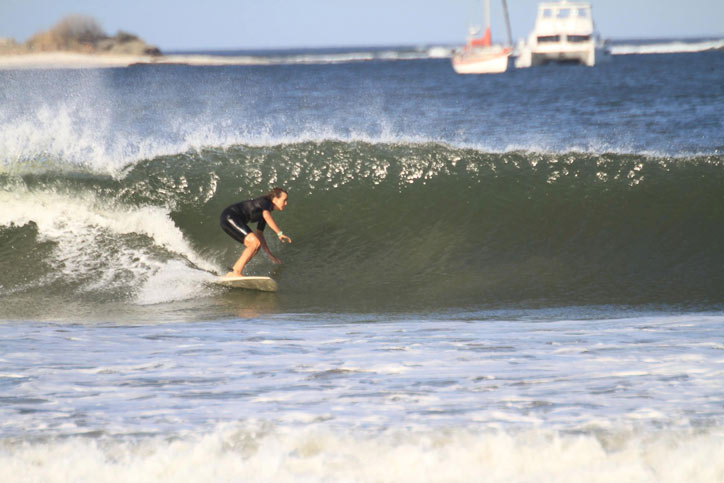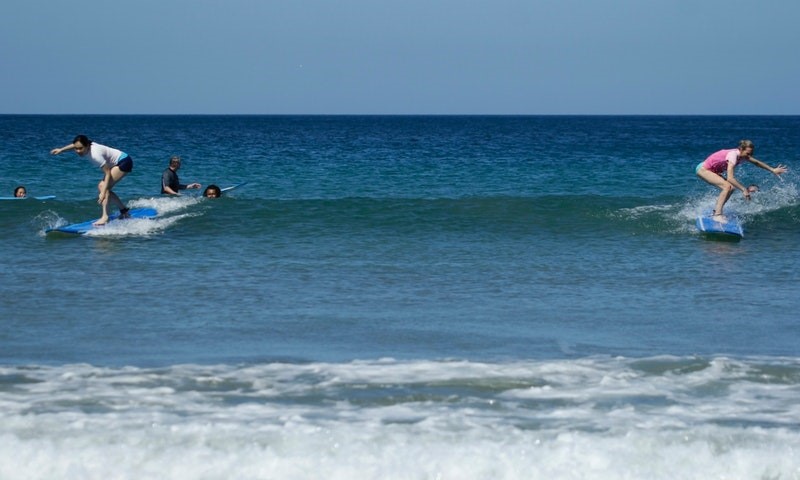In Part 1 of Ocean Science for Non-Science Majors, you learned about what makes the tides you observe in Tamarindo. But what about the waves? Does high tide mean big waves and low tide mean little waves? What do surfers mean when they talk about a “swell”? What’s the big deal about which way the wind blows? Is this going to be about the moon again?
No. The moon creates the tides, but it does not influence the size of the waves. Waves are created by wind, and strong winds make bigger waves. There are exceptions, like tsunamis, but anomalies are another subject. This post is about normal waves.
Oh, you say. So a windy day at the beach means big waves?
Nope. Not at all. Because waves, although we experience them when they hit the beach, are not formed at the beach.

Picture the vast expanse of the Pacific Ocean. Picture the storms that might pepper it on any given day. If you like live, interactive images, check out
Wind blowing across the surface of the water pushes the water into piles, so to speak, and these piles of water reach the coasts as bigger waves. A storm in the ocean has the same effect on ocean water as tossing a pebble into a mud puddle has on puddle water, just on a much larger scale. Toss the pebble in the puddle, and the ripples move out from the place the stone landed toward the edges of the puddle. That is exactly how waves, created by storms and wind in open spaces, move across the ocean toward the land. The pulse of energy from the pebble/storm will keep right on going until it hits something. While it is moving across the water, there is nothing to stop it. This is why a storm off the coast of California or Chile has Tamarindo surfers jumping up and down. The waves will eventually get here.

At the start of your vacation, you pull in to Tamarindo, excited to arrive at your Tamarindo vacation rental, and you are surprised at the size of the waves out there. You wanted to take a Tamarindo surf lesson, but wow. That looks a little scary. Huge waves lift up, then slam down. This is not exactly what the on-line pictures of surf lessons showed. Have you been tricked? No. But you have happened to arrive in town during a “swell”—a few days of extra-big waves created by storms in the ocean hundreds or thousands of miles away. Don’t worry. Swells don’t last long. In a few days, the waves will calm, settle, and turn back into their normal lazy selves.


Another thing that affects the size of the waves you see at any given beach is the shape of that beach’s geography. An excellent example of this might be comparing the waves at Tamarindo Beach to the waves at Langosta Beach, just 5 minutes to the south. Langosta’s waves are almost always bigger and stronger than Tamarindo’s. Why?
First, you need a brief anatomy lesson regarding waves. Waves are not just pointy peaks of water that stick up; waves are shaped like icebergs. Iceberg-shaped waves move freely across the deep ocean with nothing to stop them. With the exception of wild storms, the open ocean doesn’t have breaking waves the way the beach does because…waves only break when they hit something to trip and fall over. Otherwise they just slide happily along. As waves enter the Tamarindo Bay, they begin to drag along the bottom of the bay, slowing down. When they finally hit the beach, their feet are essentially dragging so much that they trip and fall on their faces. Welcome to a breaking wave. Langosta Beach is not in the back of a shallow bay. In Langosta, waves have a shorter distance between deep water and the beach, so they don’t slow down as much. They hit the beach at a run, and when they trip and fall, they fall much harder.

It’s not that difficult to understand—easier than the whole moon-and-the-tides thing, right? And you had a great surf lesson. You wish you could stay longer to practice more.
Your surf instructor kept mentioning the wind being off shore or the wind being on shore and this seemed really important to her. So what is that all about? If waves are caused by wind and storms far away, what’s the big deal about wind at the beach.
Wind at the beach doesn’t have anything at all to do with whether the waves are large or small. What wind at the beach does is affect HOW the waves break. For beach walking, sunbathing, fishing, snorkeling, scuba diving, kayaking, and pretty much any beach/ocean activity except for surfing, the wind direction doesn’t change much regarding the quality of the experience.
It does for surfing. Surfers like for the wind to blow off shore–from the land onto the ocean, and we don’t like for the wind to blow on shore–from the ocean onto the land. Here’s why:
Imagine a wave rolling across the Tamarindo bay toward the beach. Put it in slow motion. As the wave gets closer, the water gets shallower. The bottom part of the wave starts to drag across the land, which causes it to slow down and the top part to lean forward (because it’s going to fall on its face, remember?).
Now. If the wind is blowing off shore, the wind pushes against the face of the wave that is heading toward the beach. It holds against it, pushing it back. This causes the wave to sit up nice and straight like its mama told it to, gain more energy from the bottom and when it finally breaks (falls), it breaks in a crisper cleaner way that makes it much more fun for surfers to ride. If the wind is blowing on shore when that same breaking waves begins to slow on the bottom and lean forward on the top, the wind smushes it over like a bully pushing somebody who’s already starting to fall. The wave still breaks, but it does so clumsily and without the crisp solid surface that makes for a good ride.
There. You did it. You completed the course on Ocean Science for Non-Science Majors and you now know more than most people about tides, waves, and the significance of wind-direction. Now you can pop onto a website like a website like https://magicseaweed.com/Tamarindo-Surf-Report/444/, find out what time the high tide will be, and and how big of waves to expect and which way the wind is predicted to blow just like a real Tamarindo local. Doesn’t knowing how it works make it all seem even more magical?



